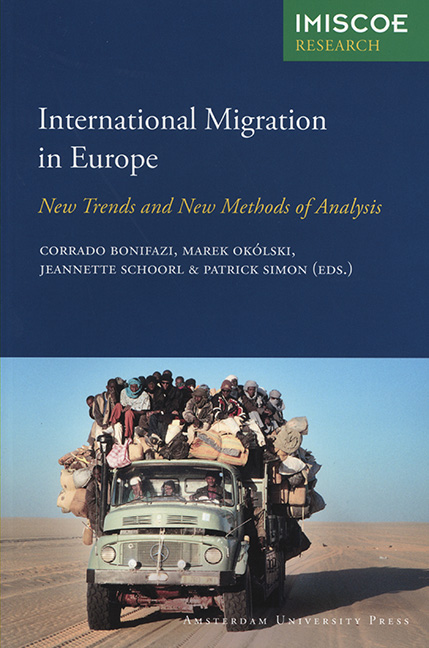Book contents
- Frontmatter
- Contents
- Preface
- 1 Introduction
- PART I NEW FORMS OF MIGRATION IN EUROPE
- PART II EVOLUTION OF REGIONAL PATTERNS OF INTERNATIONAL MIGRATION IN EUROPE
- PART III MEASURING INTEGRATION: IMMIGRANTS AND THE SECOND GENERATION
- PART IV SPECIAL SURVEYS IN INTERNATIONAL MIGRATION STUDIES
- List of Contributors
- Index
- Other IMISCOE Titles
5 - Romanian Migration Movements: Networks as Informal Transnational Organisations
Published online by Cambridge University Press: 22 June 2021
- Frontmatter
- Contents
- Preface
- 1 Introduction
- PART I NEW FORMS OF MIGRATION IN EUROPE
- PART II EVOLUTION OF REGIONAL PATTERNS OF INTERNATIONAL MIGRATION IN EUROPE
- PART III MEASURING INTEGRATION: IMMIGRANTS AND THE SECOND GENERATION
- PART IV SPECIAL SURVEYS IN INTERNATIONAL MIGRATION STUDIES
- List of Contributors
- Index
- Other IMISCOE Titles
Summary
Since the fall of the Iron Curtain, the European continent has become, as it used to be, a vast area of exchange in which human migrations take diverse forms, from virtually permanent emigration to a variety of short-term movements, such as study programmes or seasonal jobs (Okólski 2001). The kind of migration this text deals with consists of constant mobility between the native country and several places abroad where migrants work on a temporary basis. This started at the beginning of the 1990s and demonstrates how middle-class people from Eastern European countries have played a role, without waiting for international agreements, in the construction of a large transnational area across Europe.
Introduction
The cases studied here concentrate on movements between Romania and several other countries in the European Union. Even if some aspects are similar to other Eastern European countries, as regards migration, the Romanian situation is quite specific. First of all, it should be noted that unlike Poland, Hungary or Slovenia, Romanians had to apply for a visa to visit any other EU country throughout the 1990s, in fact until 2002. For years, one of the big issues delaying the entry of the country into the EU was its migratory potential and the supposed permeability of its frontiers (Michalon 2005). Indeed, the possible numbers of Romanian migrants were frightening Western societies because of the supposed consequent burglary rate. Prior to entry into the EU, Romanians could not stay in EU countries for more than three months at a time and, apart from rare instances regulated by special bilateral agreements, were not allowed to work. Even though accession to the EU occurred in 2007, during the preceding sixteen years Romania had been marginalised within the international European area, a fact which strongly restricted, but did not stop, migrations.
The country's recent past and the way the transition to capitalism was driven after the collapse of the communist regime strongly weakened the national economy and subsequently reduced the standard of living of the entire population. Having become a communist country after World War II, from 1965 to 1989 Romania was in the grip of a powerful dictatorship, harshly conducted by Nicolae Ceausescu.
- Type
- Chapter
- Information
- International Migration in EuropeNew Trends and New Methods of Analysis, pp. 87 - 104Publisher: Amsterdam University PressPrint publication year: 2008
- 2
- Cited by



